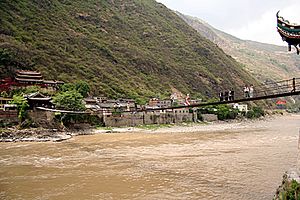Battle of Luding Bridge
| Battle of Luding Bridge | |||||||
|---|---|---|---|---|---|---|---|
| Part of the Long March (Chinese Civil War) | |||||||
 Luding Bridge seen from the side of the city |
|||||||
|
|||||||
| Belligerents | |||||||
|
|
Warlords linked to Nationalists | ||||||
| Commanders and leaders | |||||||
| Yang Chengwu | Li Quanshan | ||||||
| Strength | |||||||
| 22 | One regiment | ||||||
| Casualties and losses | |||||||
| 3 killed | Most fled or went AWOL | ||||||
Coordinates: 29°54′52.23″N 102°13′48.52″E / 29.9145083°N 102.2301444°E
The Battle of Luding Bridge (simplified Chinese: ; traditional Chinese: ; pinyin: ) of 1935 was a controversial crossing of the Luding Bridge by the soldiers of the Fourth Regiment of the Chinese Workers and Peasants' Army during the Long March. The bridge, situated over the Dadu River in Luding County, Garzê Tibetan Autonomous Prefecture, Sichuan, China, was located about 80 kilometers west of the city of Ya'an and was a river crossing vital to the Red Army.
Fleeing from pursuing Chinese Nationalist forces, the communists found that there were not enough boats to cross the Dadu River (Sichuan province). Thus, they were forced to use Luding Bridge, a Qing dynasty suspension bridge built in 1701. The bridge consisted of thirteen heavy iron chains with a span of some 100 yards. Thick wooden boards lashed over the chains provided the roadway across the bridge.
...
Wikipedia
